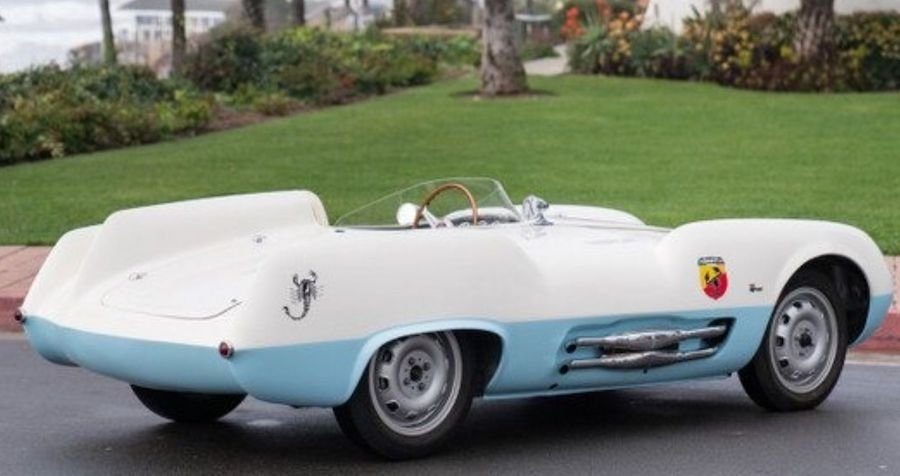Abarth 207/A: The Tiny Italian Masterpiece That Sought To Make It Big on US Racetracks

Born in Vienna, then the capital of the Austro-Hungarian Empire, Karl Albert Abarth emigrated to Italy as a teenager.
Karl, who later became Carlo, was initially a motorcycle and bicycle designer and an aspiring race driver. However, a major accident forced him to end his driving career and focus his efforts on creating fast vehicles.
By the late 1940s, Abarth became the sporting director of Cisitalia, a small race car manufacturer that he helped gain huge notoriety.
In 1948, about a year after Abarth took the motorsport reigns of Cisitalia, the company folded. That opened an opportunity for the Austrian-born designer, who, along with factory driver Guido Scagliarini, took over the Cisitalia assets and 1949 founded a new company called Abarth & C.
Over the next decade, Abarth quickly rose to fame thanks to performance upgrades like race-bred exhaust systems offered for several Italian models, mainly those from Fiat. In addition, the company also made a name for itself by developing several low-volume cars, like the Spider 1100 Abarth Corsa 207/A, a forgotten Italian icon from the 1950s.
Developed specifically for the US market
The story of the 207/A starts in the early 1950s when Abarth importer Tony Pompeo and race driver Gino Valenzano, two Italian-Americans based in Brooklyn, New York, traveled to Italy for a sit-down with Carlo Abarth.
The duo, who recognized Abarth's brilliance, reasoned the best way to boost the company's popularity on American shores was to market a flagship race car that could go head-to-head with other popular European imports from the likes of Porsche or Lotus.
The idea materialized into a 1,100-cc class racer that rolled out of the Abarth factory for the first time in 1955.
A parts bin special with a beautiful coachbuilt body
Since Abarth had a close partnership with Fiat, the new race car was heavily based on the underpinnings of the new Fiat 1100, a small and affordable car for the masses.
Though Abarth designed and built the boxed steel chassis from scratch, it borrowed the drum brakes and suspension systems from the 1100. However, the rear live axle received improved shock absorbers and coils instead of the mass-produced Fiat's semi-elliptic leaf springs.
While most of the chassis components were sourced from the Fiat 1100, the body was designed by the famed Felice Mario Boano and handbuilt by his team in the coachbuilder's Turin shop.
Fabricated from steel panels, the structure was a beautiful example of the era's fascination with aircraft design.
Small, low-slung, and featuring ample curves, the body featured fins above each wheel well, and, to improve aerodynamics even further, the entire nose was asymmetrically bulged on the driver's side.
Boano's asymmetrical design continued toward the rear, where another fin was placed behind the driver's headrest to minimize drag. Moreover, Abarth's trademark dual-pipe muffler lay exposed on the left side of the body.
The 207/A was a two-seat spyder, but the passenger side featured a steel cover that also served to improve aerodynamics, while the small windshield only covered the driver's side of the cockpit.
Powered by a massively-improved Fiat engine
As the name implied, the unit was an OHV four-cylinder that displaced 1.1 liters (more specifically, 1,089 cc). In stock form, it was rated at a mere 36 hp, but thanks to Abarth's extensive tuning, which included redesigned manifolds, dual Weber 36 DCO4 carburetors, and a compression ratio increase, the small engine was improved to 66 hp.
Even for the mid-1950s, that wasn't a huge output figure by any means. However, since the 207/A weighed only 1,151 pounds (522 kg), the engine enabled it to achieve a top speed of around 102.5 mph (165 kph).
Furthermore, the suspension setup and aerodynamic shape led to impressive maneuverability at high speeds.
Overshadowed by Lotus
The first examples of the 207/A were shipped to the US in the second part of 1955. One of them was entered in high-profile races, such as the 12 Hours of Sebring, where it finished second in its class. However, the car was subsequently disqualified due to irregular refueling.
While praised for its speed and maneuverability, the 207/A struggled to compete against the Lotus Mark IX and the new Eleven, the latter of which became virtually unbeatable in the under 1,100-cc class.
The dominance of the English lightweight specials sealed the faith of the 207/A, so Abarth only managed to sell ten units.
Furthermore, two street-legal derivatives, the 208/A Spider and the 209/A Coupe, both stylized by Giovanni Michelotti for Carrozzeria Boano, never made it into production due to the poor sales of the race car.
Although it failed to become the all-conquering race car that Abarth desired, the Spider 1100 Abarth Corsa 207/A succeeded at promoting the company in the United States, and during the next decade, its products and specialty found their way across the Pacific.
Largely forgotten today, the 207/A remains a fascinating example of a nimble lightweight special with a timeless aerodynamic body and a true Abarth icon from the company's early years.
For more info on this terrific little masterpiece, we recomand watching the video below by MyClassicCarTV




Notícias Relacionadas
